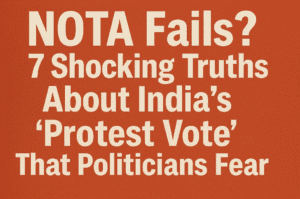NOTA Fails? 7 Shocking Truths About India’s “Protest Vote” That Politicians Fear
The Election Commission’s claim that NOTA is a “failed idea” underscores a decade-long paradox in Indian democracy. Introduced in 2013 to empower voter dissent, NOTA has consistently secured just 1% of votes nationally, reflecting symbolic protest rather than systemic impact. While exceptions like Bihar (2.07% in 2024) and Indore’s record 13.99% NOTA votes—triggered by the Congress’s candidate withdrawal—highlight localized discontent, the option lacks teeth, as it cannot invalidate results or force re-elections.
Though NOTA votes exceeded winning margins in 64 Lok Sabha seats since 2014, outcomes remained unchanged, revealing its limited influence. Structural flaws, voter disillusionment, and parties’ indifference to candidate quality perpetuate its irrelevance. For NOTA to evolve beyond a statistical footnote, reforms like mandating re-polls or penalizing parties it outperforms are essential. Until then, it remains a quiet cry for accountability in a system resistant to change.

NOTA Fails? 7 Shocking Truths About India’s “Protest Vote” That Politicians Fear
The Election Commission’s recent assertion in the Supreme Court that the ‘None of the Above’ (NOTA) option is a “failed idea” has reignited debates about its purpose and impact. Introduced in 2013 following a Supreme Court directive, NOTA was envisioned as a tool to empower voters and pressure political parties to field credible candidates. Over a decade later, data reveals a paradox: while NOTA persists as a protest vote, its influence on electoral outcomes remains negligible.
The Numbers Behind NOTA’s Limited Impact
Since its debut in the 2013 Assembly polls and the 2014 Lok Sabha elections, NOTA’s vote share has consistently hovered around 1% nationally. In the 2024 general elections, it secured 1.07% of votes, marginally lower than previous cycles. Despite sporadic spikes—like Indore’s record 13.99% NOTA votes in 2024 after the Congress withdrew its candidate—the option has rarely disrupted results. Only three constituencies (Bastar in 2014, Gopalganj in 2019, and Indore in 2024) have seen NOTA cross 5%, underscoring its symbolic rather than decisive role.
Lok Sabha Trends:
- 2014: 1.1% (60 lakh votes)
- 2019: 1.07% (65 lakh votes)
- 2024: 1% (63.7 lakh votes)
States like Bihar stand out, with NOTA consistently outperforming national averages (2.07% in 2024). Analysts attribute this to entrenched voter disillusionment and the absence of credible alternatives in caste-driven politics. Similarly, Naxal-affected regions like Chhattisgarh’s Bastar have seen NOTA emerge as a protest against systemic neglect.
Assembly Elections: A Gradual Decline
In state polls, NOTA’s influence has waned. From a peak of 2.09% in 2015 (Bihar and Delhi), its vote share dropped to 0.9% in 2023–24. While outliers exist—like Maharashtra’s Latur Rural (13.78% NOTA in 2019) due to intra-party dissent—the option seldom alters outcomes. Of 76 Assembly elections since 2013, NOTA exceeded 1% in only 37, with Chhattisgarh (3.07% in 2013) and Bihar (2.48% in 2015) leading.
When NOTA Almost Mattered
In 64 Lok Sabha and 601 Assembly constituencies, NOTA votes surpassed the winner’s margin, hinting at its latent potential. For instance, Uttar Pradesh saw six such seats in 2024, reflecting voter discontent in tightly contested regions. However, without legal provisions to trigger re-elections, these votes remain symbolic.
Why NOTA Struggles to Make Waves
- Structural Limitations: NOTA’s design—it cannot invalidate results—limits its power. The Supreme Court’s 2013 ruling prioritized voter expression over electoral consequences.
- Voter Psychology: Many view NOTA as a futile gesture, opting instead for tactical voting or abstention. In Indore, while NOTA’s surge made headlines, the BJP still won by a landslide.
- Candidate Proliferation: Data suggests NOTA performs worse in seats with over 20 candidates, as voters gravitate toward fringe parties rather than rejecting all options.
The Bihar Paradox
Bihar’s affinity for NOTA highlights deeper electoral dynamics. In SC-reserved seats like Gopalganj, marginalized communities often use NOTA to protest unresponsive representation. Similarly, fragmented opposition in Bihar’s multi-cornered contests amplifies NOTA as a default protest tool.
Reimagining NOTA’s Role
Advocates argue for systemic reforms, such as:
- Mandating re-elections if NOTA wins.
- Requiring parties to lose deposits if NOTA outpaces their candidates.
- Enhancing voter awareness to transform NOTA from a protest tool to a accountability mechanism.
Conclusion: A Gesture in Search of Meaning
NOTA’s journey reflects a clash between idealism and political reality. While it empowers voters to voice dissent, its lack of teeth perpetuates cynicism. For NOTA to evolve beyond a “failed idea,” legal reforms and voter education must align with its original intent: fostering accountability in India’s democracy. Until then, it remains a statistical footnote—a quiet rebellion with no roadmap for change.
You must be logged in to post a comment.